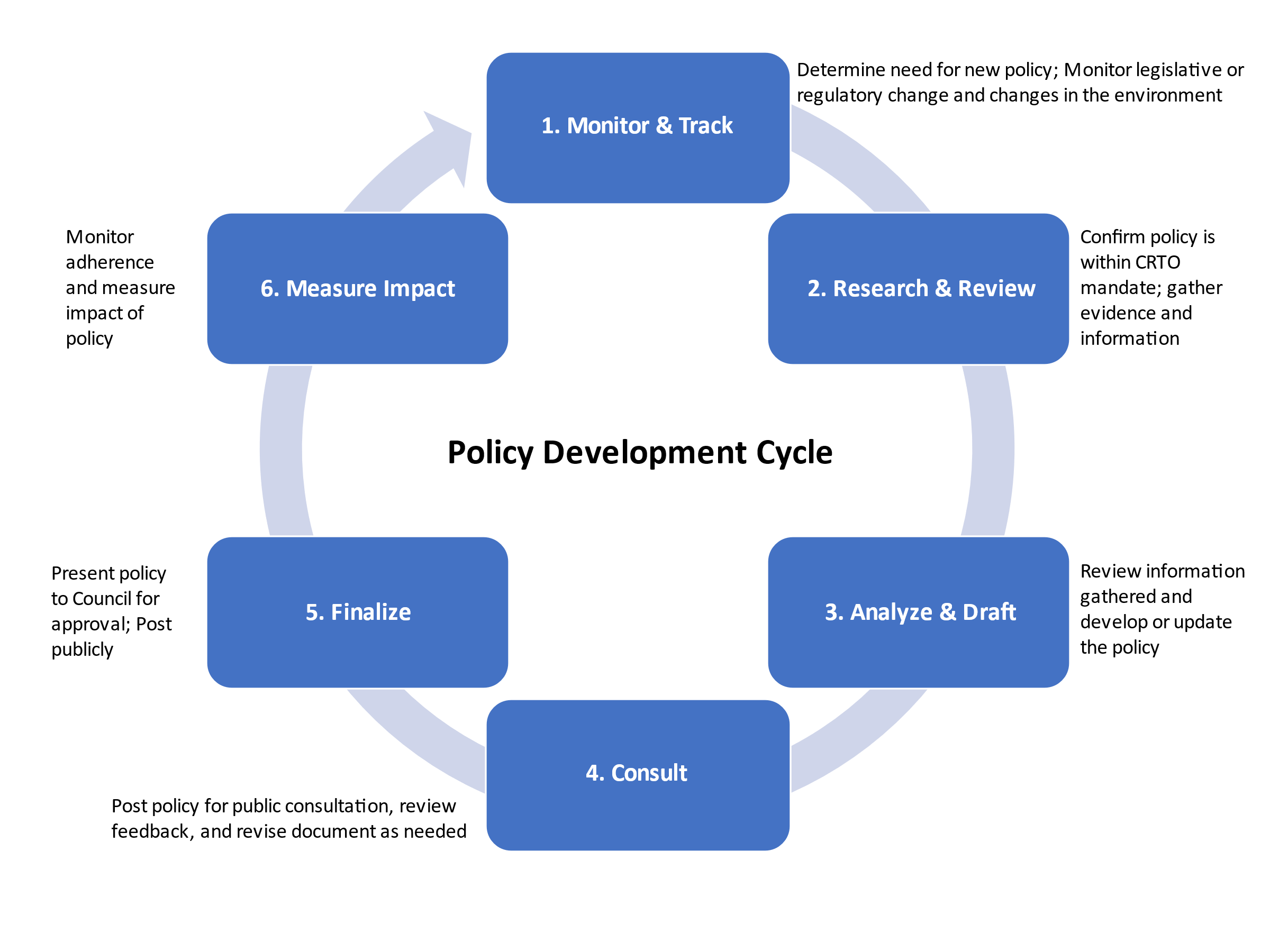The process below outlines the steps the College of Respiratory Therapists of Ontario (CRTO) will take to develop its policies and other related documents. Note that the CRTO also develops Practice Standards and Guidelines, and the development of these documents follows a separate process.
1. Monitor and track
The CRTO will monitor the environment to determine the need to update or create policies. This will include monitoring for:
- Legislative or regulatory change
- Changes in the healthcare environment that need to be addressed (changes in practice, patient experience, current affairs, and other trends)
The CRTO will ensure existing policies are reviewed and updated every five years. More time-sensitive documents such as Position Statements will be reviewed on a shorter, 2-year interval.
2. Research and Review
Once it has been determined that a policy or other regulatory document needs to be developed or revised, the CRTO will:
- Confirm the policy is within the CRTO’s mandate, and that development of the policy is warranted, based on the guiding principles of the CRTO’s Policy Framework;
- Review the Policy Framework to determine which type of document is needed (i.e. Policy, Fact Sheet, Professional Practice Guideline, Practice Policy, Resource, etc.);
- Conduct a literature review to gather the most current evidence on the topic;*
- Conduct a jurisdictional and environmental scan to determine the approach and position taken by the profession as well as any other relevant regulated health colleges, both in Ontario and abroad;*
- Review the current patient experience on the issue (for example, existing or foreseeable risks, complaints and experiences that relate to the need of the policy being created or reviewed)*
* In some cases, this could be supported through forming a working group including external subject matter experts, patients and the public.
3. Analyze and Draft
The information gathered above will be analyzed by the CRTO and used to develop or update the policy or related document.
4. Consult
Once the policy or related document is drafted, it will be posted for a 30 – 60 day public consultation period. This time range allows for flexibility depending on the urgency or depth of the topic. The CRTO will encourage participation in the consultation through various methods such as its existing communication channels, social media, focus groups and citizen advisory groups, using its Public Consultation Process to guide the level of involvement. To ensure transparency and encourage open dialogue, feedback will be posted publicly and anonymously, and will remain on the CRTO’s website after the consultation has closed.
Once the consultation period has ended, the CRTO will review the feedback and, as appropriate, make relevant changes to the draft policy (or related document). This may require additional research and analysis to be conducted.
5. Finalize
A finalized version of the document will be developed. All Policies, Position Statements, Professional Practice Guidelines, and Practice Policies will be presented to Council for approval (along with a summary of the consultation results).
Once approved and finalized, the new or revised document will be communicated via the channels mentioned above.
6. Measure Impact
Monitoring adherence to the policy and measuring its outcomes is an important part of the policy process. The CRTO will continually assess whether the policy is accomplishing the goal it was intended to meet and where relevant, determine indicators that measure outcomes related to the policy.
Acknowledgements: This policy development cycle was adapted from the Policy Cycle developed by the Ontario College of Pharmacists.

